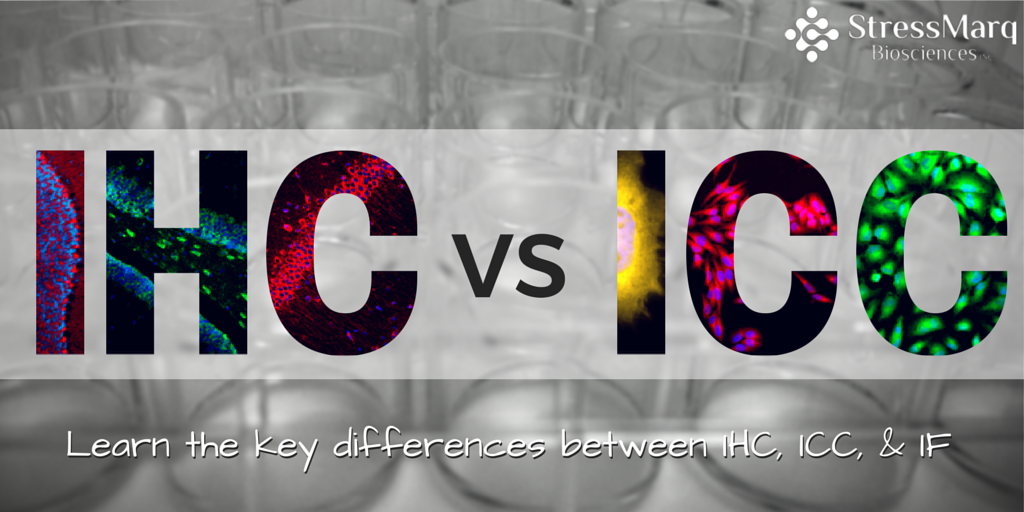Immunohistochemistry vs Immunocytochemistry: Updated Definitions & Detection Methods
Originally published by StressMarq Biosciences Mar 2015 | Updated July 2025
While IHC and ICC are often confused, they differ significantly in sample type and detection method. This 2025 update clarifies terminology, highlights new best practices, and introduces more precise nomenclature for immunostaining techniques.
Clarified Definitions and Sample Types
Immunohistochemistry (IHC) is performed on tissue sections, such as paraffin-embedded or frozen samples, preserving the architecture of the extracellular matrix. Immunocytochemistry (ICC), on the other hand, is used on individual cells, such as cultured cells or smears, often without extracellular matrix.
Detection Methods: Chemistry vs Fluorescence
Both IHC and ICC can utilize enzymatic colorimetric detection methods (e.g., DAB) or fluorescent detection (IF). The suffix “-fluorescence” (e.g., immunohistofluorescence) is increasingly used to clarify the detection method while preserving sample type specificity.
Updated Terminology Recommendations
Experts recommend using terms like immunohistofluorescence and immunocytofluorescence to avoid ambiguity when fluorescence is used. This distinction between sample type and detection method is critical for reproducibility and antibody validation.
Thermo Fisher’s Updated Comparison Guide
Thermo Fisher Scientific provides a detailed comparison of sample preparation, fixation, and antibody compatibility for IHC vs ICC. Their guide includes visual examples of staining in A549 cells (ICC) and colon carcinoma tissue (IHC).
Original StressMarq Blog (2015):
People often confuse the terms immunohistochemistry, immunocytochemistry, and immunofluorescence. These terms should not be used interchangeably for any method of immunostaining.
I’ve outlined the key differences so you don’t make a newbie mistake by using the wrong term in an abstract or presentation. Let’s start by breaking down these terms into their prefixes, roots, and suffixes.
Root Word Meanings:
For the most part, the terms immunohistochemistry and immunocytochemistry are used correctly for their broad meaning to “use an antibody to detect an antigen” in a tissue or cell, respectively.
The problem arises when people use a fluorophore to detect the primary antibody, either through a direct conjugation to the primary antibody or through a labelled secondary antibody.
This technique is then labelled as immunofluorescence. This term only reveals the detection method that was used, not the sample type.
Biotech companies often designate their primary antibodies as being tested for use in immunofluorescence. What does this tell you? Not much.
If you are trying to choose a product based on whether they have been validated for use in particular application, the most important consideration is whether it has been validated in your sample type (ie. tissue or cells), not the detection system (-chemistry or -fluorescence).
This is why I find immunofluorescence as an application term for primary antibodies to be especially useless.
In a perfect world I would love to see “-chemistry” replaced with “-fluorescence” at the end of each term when necessary. This would indicate which visualization method was used, while keeping the sample type information.
Proposed Nomenclature for Immunostaining Techniques
| Tissue (-histo) | Cells (-cyto) | |
| Chemical detection
(-chemistry) |
Immunohistochemistry | Immunocytochemistry |
| Fluorescent detection
(-fluorescence) |
Immunohistofluorescence | Immunocytofluorescence |
Key Definitions
Immunochemistry (IC) Definition
Detection of a target using an antibody and subsequent visualization using a chemical reaction to produce a color change.
 Immunohistochemistry (IHC) Definition
Immunohistochemistry (IHC) Definition
Detection of a target in tissue using an antibody and subsequent visualization using a chemical reaction to produce a color change.
 Immunocytochemistry (ICC) Definition
Immunocytochemistry (ICC) Definition
Detection of a target in cells using an antibody and subsequent visualization using a chemical reaction to produce a color change.
Immunofluorescence (IF) Definition
Detection of a target using an antibody and subsequent visualization using a fluorophore
 Immunohistofluorescence (IHF) Definition
Immunohistofluorescence (IHF) Definition
Detection of a target in tissue using an antibody and subsequent visualization using a fluorophore
 Immunocytofluorescence (ICF) Definition
Immunocytofluorescence (ICF) Definition
Detection of a target in cells using an antibody and subsequent visualization using a fluorophore
I didn’t coin these terms, but checking the google search volumes for each of them clearly shows that there is a long road ahead of us if we want these terms to take over as the norm.
Since immunofluorescence (IF) as a term is still widely used, we caved to peer pressure and grouped it in with our immunocytochemistry (ICC) application term, as those two techniques are often combined.
This results in the ICC/IF abbreviation that you will see used throughout our website.
Any antibody labeled as being tested for use in ICC/IF has been validated using cells with a secondary antibody conjugated to either a fluorescent or enzyme/protein tag.
If you see the abbreviation for immunohistochemistry (IHC), it means that the antibody can be used in tissue with a secondary antibody conjugated to any tag, as that does not affect the binding of the primary antibody.
Looking for more information on IHC and ICC protocols and techniques? We will have subsequent blogs on these applications in the coming weeks. Stay tuned!
Performing immunofluorescence? View StressMarq’s fluorescent conjugates.
Doing immunochemistry instead? View StressMarq’sprotein/enzyme conjugates.


I love what you wrote. These terms should take over as a norm. It is very clear what each abbreviation stands for.
Can a antibody labelled for being used in ICC be used in IHC, or the reverse, if the tissue and cells have the same source??
thank you for the lesson 🙂
thank you for your very useful information